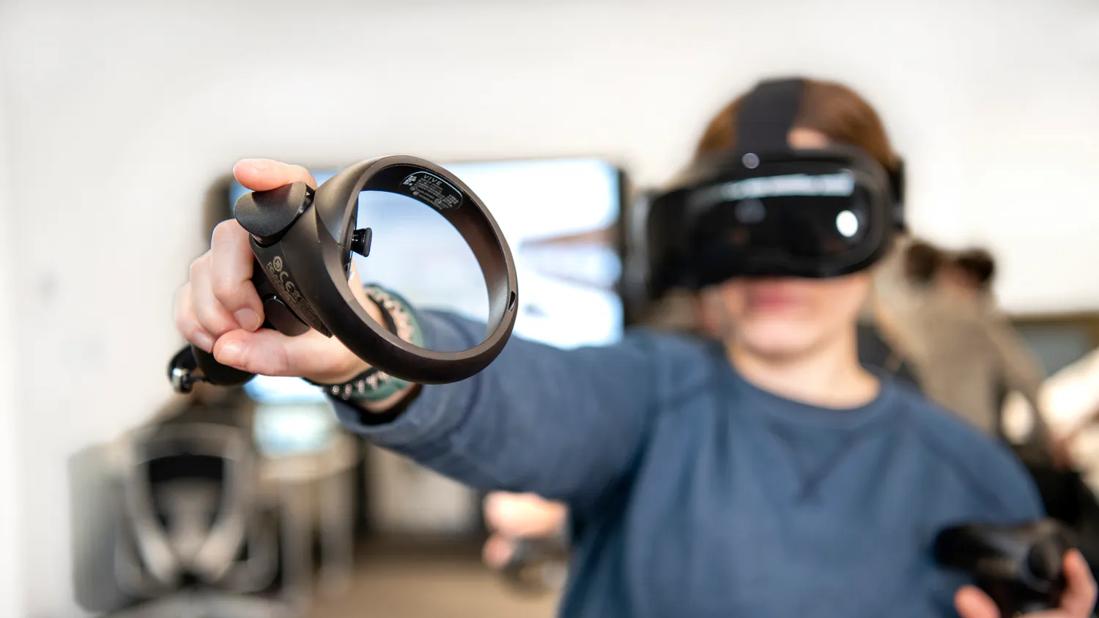Clinicians embrace immersive technology to learn real-world skills

Faced with a growing need to provide clinical learning experiences, healthcare leaders are increasingly looking to simulation as a practical, hands-on solution. In particular, virtual reality (VR) is rapidly gaining momentum as a novel teaching tool, thanks to its ability to engage trainees in high-tech, experiential scenarios.
Advertisement
Cleveland Clinic is a non-profit academic medical center. Advertising on our site helps support our mission. We do not endorse non-Cleveland Clinic products or services. Policy
But how well does VR live up to the hype? A new pilot project at Cleveland Clinic sheds light on the opportunities and challenges that accompany this cutting-edge technology and its growing importance in medical education. Although it can be a powerful and engaging training tool, experts say that VR may be most useful in specific, specialized scenarios.
“Virtual reality offers clear advantages for training, especially in large, multisite hospital systems like Cleveland Clinic,” explains Nichole Brown, MSN, RN, CHSE-A, Simulation Education Specialist. “We strive to standardize care across all our facilities, and VR is a particularly promising solution that allows learners to take part in the same exercises, regardless of their location. Despite our optimism, however, there is still much to learn about how the technology can be used most effectively to train clinicians.”
Cleveland Clinic’s Simulation and Advanced Skills Center was tasked with developing a VR training program in 2021. After selecting a platform and integrating it into hospital systems, the team executed its first VR training session in May 2022, during which learners at three different sites participated in a mock code simulation. The event was a success, says Jessica Rinard, AAS, COTA, Simulation Operations Specialist, but the team found the first session to be especially time and labor intensive.
“Most of our learners had never used VR before, so we had to start with the basics — like how to use a headset,” she says. “We also had to train participants to navigate the software: How does the virtual environment work? How do you pick up medical equipment? How do you pass an item off to another team member? All these questions had to be addressed.”
Advertisement
The session also required the presence of two simulation specialists at each site, along with a central moderator and facilitator to manage the mock scenario. “When people think of VR, they often assume it’s a quick, simple and less resource-intensive training approach; however, our pilot showed that this may not always be the case,” says Michelle Feliciano, MEd, CHSE-A, Simulation Education Specialist. “Despite the learning curve that accompanies VR, our program highlights the advantages that the technology brings to the healthcare space.”
Learners reported that the immersive platform made the clinical scenarios feel more realistic than traditional simulations. Even when the graphics aren’t convincing — such as when blood is represented on screen by a red blob — the scenario feels “real” because VR allows participants to interact with the whole environment, says Maureen Washock, BSN, RN, CPN, CHSE, Simulation Education Specialist. For example, VR can depict a 360-degree view of an operating room, while a manikin simulation might be performed in a conference room or multipurpose area.
“To get the most out of a traditional simulation exercise, participants have to use their imaginations to really buy into the scenario, but with VR, learners are fully engaged from the beginning,” says Washock. “The technology pulls you in right away.”
Learners also feel more anonymous and less self-conscious about being observed when using VR, Brown notes. “When you’re in a live scenario, you’re very aware that you’re being watched. In some cases, you may even be working in front of a two-way mirror,” she says. “No one wants to look silly, of course, so this dynamic can cause learners to hesitate.”
Advertisement
Standardization is another advantage of VR, adds Washock, because each scenario can be run repeatedly without variation. “The technology can provide the same experience, regardless of the learner’s location,” she says. “Whether you’re at a low-resource facility where we’ve shipped a headset or you’re on main campus and equipped with all the bells and whistles, the simulated scenario is exactly the same.”
Despite its many advantages, Brown cautions that VR isn’t right for every situation. In particular, the equipment can be cumbersome when training large groups and is of little value for teaching psychomotor skills, she says. “It’s difficult to simulate an intubation, for example, because VR doesn’t have the capacity to provide haptic feedback,” she explains.
Instead, VR simulation may be better suited to team training, decision-making scenarios and communication exercises, says Rinard. In addition, facilitators should be aware that some people are simply unable to tolerate VR, she says. “It’s important to keep an eye out for cyber sickness, which can make participants feel dizzy, nauseated and even disoriented in their environment,” she says.
In the coming months, the team plans to create custom training scenarios that are standardized to Cleveland Clinic practices. They’re also looking for opportunities to evaluate and study VR training outcomes.
“Virtual reality is an exciting trend in healthcare, but it’s still quite new,” says Brown. “There is currently little evidence to support best practices, but I think this is where our work can make a difference. By continuing to evaluate the platform, not only do we aim to inform our own health system about the most productive ways to use VR, but we also hope to educate the larger simulation community.”
Advertisement
Advertisement

Advanced connectivity and technologies build on a foundation of teleneurology leadership

Home weight monitoring in healthy newborn infants is feasible

Cleveland Clinic Abu Dhabi initiative reduces ICU admissions and strengthens caregiver collaboration

Veteran nurse blends compassion, cutting-edge transplant training and military tradition to elevate patient care

Embrace coaching and other tips to be a stronger leader

Compassion, communication and critical thinking are key

How hospitals can weave ethics into daily nursing practice to strengthen patient-centered care

Guiding nurses amid a constantly evolving healthcare landscape